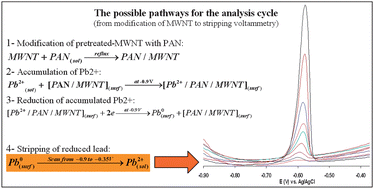Multiwalled carbon nanotube modified with 1-(2-pyridylazo)-2-naphthol for stripping voltammetric determination of Pb(ii)
Abstract
The present work is focused on the modification of multiwalled

* Corresponding authors
a
Department of Chemistry, Payame Noor University (PNU), P.O. Box 76175-559, Kerman, Iran
E-mail:
mohadesi_a@yahoo.com
b Department of Chemistry, Shahid Bahonar University of Kerman, P.O. Box 76175-133, Kerman, Iran
The present work is focused on the modification of multiwalled

 Please wait while we load your content...
Something went wrong. Try again?
Please wait while we load your content...
Something went wrong. Try again?
A. Mohadesi, Z. Motallebi and A. Salmanipour, Analyst, 2010, 135, 1686 DOI: 10.1039/C0AN00115E
To request permission to reproduce material from this article, please go to the Copyright Clearance Center request page.
If you are an author contributing to an RSC publication, you do not need to request permission provided correct acknowledgement is given.
If you are the author of this article, you do not need to request permission to reproduce figures and diagrams provided correct acknowledgement is given. If you want to reproduce the whole article in a third-party publication (excluding your thesis/dissertation for which permission is not required) please go to the Copyright Clearance Center request page.
Read more about how to correctly acknowledge RSC content.
 Fetching data from CrossRef.
Fetching data from CrossRef.
This may take some time to load.
Loading related content
